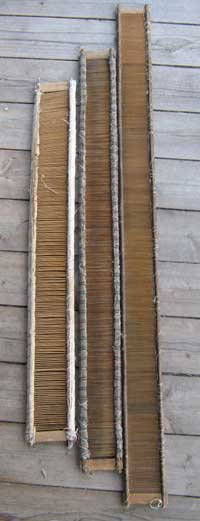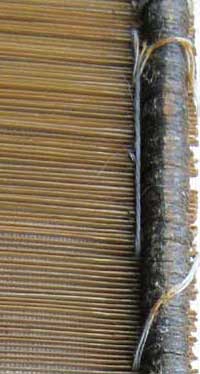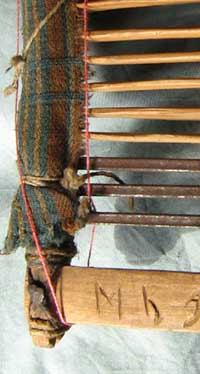About old wooden reeds from Sweden
Over the years, I have acquired several old reeds, reeds with dents made of wood (or "reeds", perhaps - I had heard the story of why they were called "reeds".)For every new reed added to the collection, I measured the number of dents per 10 cm (as in the modern system), noted it and put the reed in among the others. Sometimes I used them, but mostly I used my modern reeds.
Then, one day, someone sent me an article about wooden reeds. It contained several statements
that seemed very odd. I decided to make a systematical survey of the reeds I had. (Later,
I borrowed all wooden reeds I could get my hands on, just to compare).
Then I searched for (Swedish) literature. There wasn't
much to be found.
I learned several things - some of them conflicting.
A few things I can tell you for a fact: old reeds come in many different widths, in many different
densities, whatever literature says.
I have seen reeds from 70 cm to 119 in length; I have seen densities from 17 to 129 dents/10 cm.
Another interesting measure is the height. The lowest of the wooden reeds is 5,5 cm, the tallest is
almost 8. (When I first started weaving most reeds available were 10 cm high – nowadays 12,5 cm is
getting to be the norm. My AVL does not accept reeds lower than 5" = 12,5 cm).
"Subdivisions"?:
Often the old (Swedish) reeds have a piece of thread going along one of the sides, going back and
forth every (something) dent.
There are several systems for these subdivisions. Among my reeds, there are those divided into 20, 30
(common), 48 (common), 50 and 60 dents. Three of them also have ink marks every 60th dent (and one
of those has a thread marking every 30th dent).
A weaving book from 1925 (Montell-Glantzberg: Vävboken, downloadable from handweaving.net -
here)
even instructs us that every new reed has to be so marked, before use!
So, why 30, 48, 60?
According to Grenander-Nyberg there were several systems for dividing a skein. Those subdivisions
hold a different number of ends, and has different names in different parts af the country.
There were at least 3 systems used at the same time: 60 ends was a "pasma", 96 ends
was a "bund" and the (not completely successful) "official" system of
100 ends/turns to a "pasma".
It seems two ends per dent was the most common sleying pattern. Marking every 30th dent meant the
"pasma" here was the 60-end one; marking every 48th dent implies the 96-end "bund"
was in use.
Why these "odd" numbers, nobody knows today – Grenander-Nyberg argues it has to do with
the most popular/common methods/weaves/structures in the region in question.
About 1750 there were tries to "impose" the 100-end standard all over the country.
(This was met with varying success, as the book from 1925 shows...)
Sometimes weaving width was calculated in "pasmor" – which is a number, rather than a fixed width (or sett). Of course, as (?) your reed was marked in "pasmor", this made good sense. (Read more in the article about old weaving literature)
Such seeming confusion was not a specifically Swedish trait, though. For some riveting reading
about width and sett calculations in the UK, read Murphy: A Treatise on the Art of Weaving
from 1842 (downloadable
here).
Murphy describes, as I understand it, industrial systems.





